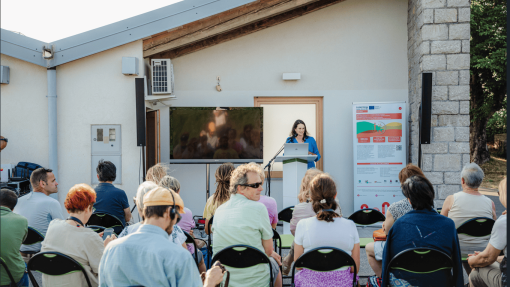On Saturday, 7 June, there was great excitement in Vojščica on Karst.
The quiet Karst village overlooking the sea became the stage for a new festival of castellieri - festival of castles - which was simply called TABR, named after the part of the village called “Tabor”, a hill above the village where the cemetery and the remains of the old St Vitus church are now located.
Tabor was once also a prehistoric settlement - a castelliere - dating back to the Bronze Age (2nd millennium B.C.), with a dominant position and a view across the Karst to the sea. It is precisely for this reason that Vojščica has become the main venue for the festival, which was created as part of the ITA-SLO Interreg project KAŠTellieri, in which the public organisation Miren Kras also participates as a partner.
By organising the festival, we wish to bring the public closer to the rich heritage of prehistoric hill-forts, which is very much present in the Municipality of Miren-Kostanjevica, as well as in the Karst region and the cross-border area. It is important for the wider public to get to know, see and internalise this heritage, which unites us all - and which we can all help preserve and protect for future generations. Unfortunately, the heritage of the castellieri has long been neglected and, with the abandonment of agriculture and grazing, these landscapes have been overgrown and forgotten. As part of the KAŠTellieri project, through various activities, we will clean, digitise and revitalise parts of these castellieri and include them in new tourist products," says Anja Sedevčič Lasič, project manager at the public organisation JZ Miren Kras.
The event was organised in cooperation with the local association ŠKTD Farjovca, with the hope that the festival will continue beyond the end of the project, scheduled for October 2026.
What could visitors experience on Saturday during the festival?
A rich daily programme began as early as 9 a.m. with a guided excursion from one castelliere to another, conducted in Slovenian and Italian. The 8-kilometre circular route took participants to two castles - Tabor near Vojščica and Grmače near the village of Novelo. The latter still has a well-preserved outer wall, up to six metres high in places.
Participation was very high, and the organisers were particularly pleased to see excursionists not only from Italy (Trieste, Ronchi, Udine), but also from further afield in Slovenia (Novo mesto, Ljubljana, Slovenske Konjice).
Afternoon in the style of a creative workshop
From 14:00 to 18:00, activities were held at five different locations in the village of Vojščica:
A stone sculpture workshop was held in front of the Church of St Vitus, led by stonemason Petra Pika Moze from Lipa. Visitors were able to carve a souvenir with motifs from the period.
Next to the old school in Vojščica, the smell of prehistoric cuisine was in the air. Under the guidance of archaeologist Polona Janežič, participants discovered ingredients, preparation methods and culinary techniques of the time.
At the Rogelja herb farm, Magda Rogelja guided visitors through the field of flowering herbs and, in a special ritual, introduced them to the use of herbs, which they were also able to taste.
At the Poščenik pond, a little outside the village, two workshops were held: making bows and flutes, and weaving St John's wreaths.
Evening on Tabor
In the late afternoon, the programme moved to the Tabor area, near the present cemetery. On a beautiful plateau with a view of the sea, amidst the ruins of the ancient church, scientific lectures were held from 18:30 to 20:00.
Archaeologists Dr. Maša Saccara, Dr. Tomaž Fabec, Dr. Federico Bernardini and Dr. Peter Turk presented the archaeological heritage of Karst, the research carried out so far, and the results of the LIDAR survey analyses carried out as part of the project. The unexpected participation of many locals showed a strong interest in this type of heritage.
Conclusion with music and stars
The day ended with a special performance by the musical group TRŠ, which plays instruments made from the wood of a 6500-year-old fir tree found in Čadrg.
The band members, Jani and Samo Kutin (also known for the Bakalina project), discovered the wood during the restoration of an old pond in Čadrg two years ago. The fir trees, perfectly preserved underground for thousands of years, were cut, seasoned and analysed: their age was estimated at between 6500 and 6580 years - thus dating back to the Neolithic period.
The wood, in exceptionally good condition, retained all the properties that make it suitable for processing. Samo Kutin proposed to make musical instruments from this material, thus giving wood a new “eternity” and enhancing the incredible discovery. Over the past two years, several unique instruments have been created: flutes, fujare, lyres, harps - and a viola is currently being crafted by master luthiers in Škofja Loka.
With the development of these musical instruments also came the idea of founding an ensemble that would play them.
Thus, the opening performance of the TRŠ group was not only an artistic event, but also a historical one, symbolically ending the festival day in a beautiful location, accompanied by the sounds of prehistoric wooden instruments.
The concert was followed by socialising with astronomy enthusiasts and stargazing with telescopes - the night sky was clear and welcoming, allowing us to catch many glimpses of the infinite.
The organisers happily concluded the 1st edition of the TABR festival in Vojščica and are already optimistically announcing its continuation - next year with an even richer programme!
The day ended with a special performance by the musical group TRŠ, which plays instruments made from the wood of a 6500-year-old fir tree found in Čadrg.
The band members, Jani and Samo Kutin (also known for the Bakalina project), discovered the wood during the restoration of an old pond in Čadrg two years ago. The fir trees, perfectly preserved underground for thousands of years, were cut, seasoned and analysed: their age was estimated at between 6500 and 6580 years - thus dating back to the Neolithic period.
The wood, in exceptionally good condition, retained all the properties that make it suitable for processing. Samo Kutin proposed to make musical instruments from this material, thus giving the wood a new “eternity” and enhancing the incredible discovery. Over the past two years, several unique instruments have been created: flutes, fujare, lyres, harps - and a viola is currently being crafted by master luthiers in Škofja Loka.
With the development of these musical instruments also came the idea of founding an ensemble that would play them.
Thus the opening performance of the TRŠ group was not only an artistic event, but also a historical one, symbolically ending the festival day in a beautiful location, accompanied by the sounds of prehistoric wooden instruments.
The concert was followed by socialising with astronomy enthusiasts and stargazing with telescopes - the night sky was clear and welcoming, allowing us to catch many glimpses of the infinite.
The organisers happily concluded the 1st TABR festival in Vojščica and are already optimistically announcing its continuation - next year with an even richer programme!

